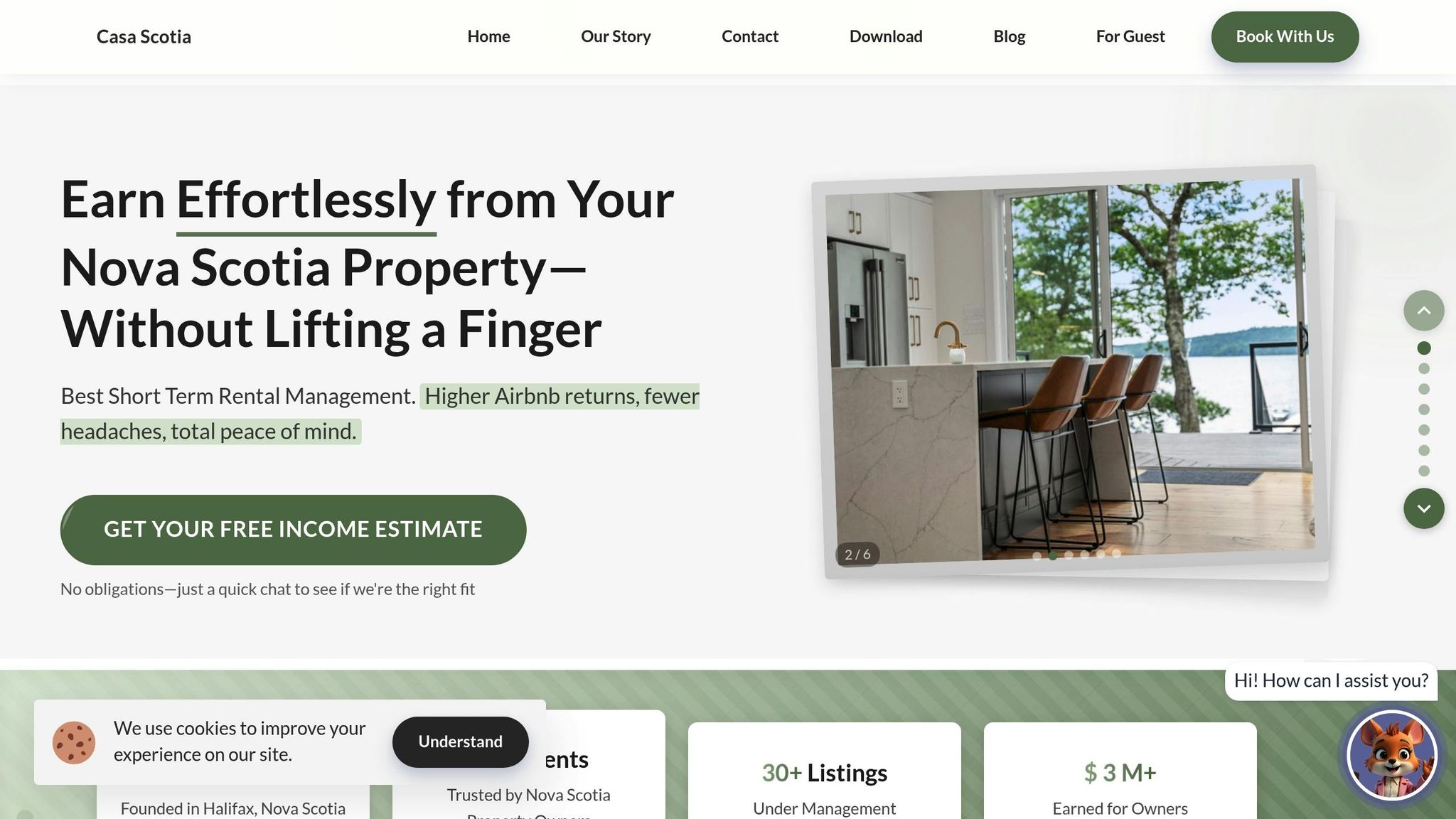Managing short-term rentals in Nova Scotia requires clear agreements to avoid risks and maximize returns. A well-written management agreement includes:
- Performance Metrics (KPIs): Track occupancy rates, average daily rates (ADR), revenue per available room (RevPAR), and guest satisfaction to measure success.
- Fee Transparency: Understand percentage-based fees, flat fees, or hybrid models. Ensure all costs, including cleaning, maintenance, and marketing, are clearly outlined.
- Exit Clauses: Define termination conditions, notice periods (30–90 days), and how existing bookings and finances will be handled.
- Regulatory Compliance: Stay aligned with Nova Scotia's short-term rental rules, including registration and tax obligations, to avoid fines.
Casa Scotia offers tailored services, including real-time KPI tracking, regulatory support, and transparent agreements, ensuring property owners can focus on their goals. Whether you're managing a condo in Halifax or a coastal home, clear agreements ensure smooth operations and protect your investment.
For Nova Scotia property owners, strong agreements are not just helpful - they're necessary to navigate local rules, seasonal demands, and guest expectations effectively.
Key Performance Indicators (KPIs) in Management Agreements
What KPIs Are and Why They Matter
Key Performance Indicators (KPIs) are measurable metrics that help evaluate how well your property management company is doing. Think of them as a report card that uses hard data to assess performance.
In short-term rental management agreements, KPIs transform vague promises into measurable results. Instead of general statements like "we'll increase your revenue", KPIs provide specific data points that clearly show how your property is performing [4][5].
For Nova Scotia short-term rental agreements, some of the most commonly tracked KPIs include occupancy rates, average daily rates (ADR), revenue per available room (RevPAR), and guest satisfaction scores. Together, these metrics paint a detailed picture of financial success, market positioning, and guest experience.
Without clearly defined KPIs in your management agreement, you're essentially left guessing. While monthly revenue reports can give you numbers, they often lack the context needed to assess whether your property is doing well or has untapped potential. KPIs provide the insights you need to make smart decisions about your property management strategy. Now, let’s dive into the specific KPIs that matter for Nova Scotia properties.
Common KPIs for Nova Scotia Properties
- Occupancy Rate: This measures the percentage of booked nights against available nights. Comparing this to local averages is key. For example, if a Halifax waterfront condo hits an 85% occupancy rate in the summer while the neighbourhood average is 65%, it could signal effective marketing - or it might mean pricing strategies need a closer look.
- Guest Satisfaction: Guest ratings, response times, and cancellation rates are essential metrics in Nova Scotia's competitive tourism market. These numbers give you a clear sense of how well your property is meeting visitor expectations.
- Revenue per Available Room (RevPAR): By factoring in both occupancy and pricing, RevPAR shows how much revenue your property is generating overall. For instance, a property with 70% occupancy at CA$180 per night will earn more than one with 90% occupancy at CA$120 per night. It’s a great way to assess your pricing strategy.
- Seasonal Performance Tracking: Nova Scotia’s tourism market changes with the seasons, so it’s important to evaluate performance across different times of the year. For example, a coastal property in Lunenburg County might aim for 80% occupancy in July but only 30% in February. Both figures can indicate strong performance when viewed in the context of seasonal demand.
How Casa Scotia Tracks and Reports KPIs

Casa Scotia takes these KPIs a step further by offering real-time, transparent data tracking. Using advanced analytics tools, Casa Scotia monitors and reports on KPIs, giving property owners access to performance data through an owner portal. This system tracks occupancy trends over time, helping you understand shifts in your property’s popularity and the effectiveness of marketing and pricing strategies.
Monthly reports dig deeper into reservation trends, pinpoint underperforming periods, and highlight new opportunities. Instead of generic data, these reports provide area-specific comparisons, showing how your property stacks up against similar listings.
The owner portal also features automated KPI tracking, with options to export data and share performance summaries. This means you can check key metrics - like occupancy rates, guest satisfaction scores, and revenue figures - whenever you need them, without waiting for the next monthly report.
11 Key Performance Metrics Every Property Manager NEEDS to Track
Fee Structures and Transparency in Management Agreements
Once you've clarified performance metrics, the next step in evaluating management agreements is understanding how fees are structured.
Types of Management Fees in Nova Scotia
Short-term rental agreements in Nova Scotia typically include a variety of fees. Here's a breakdown of the most common ones:
- Percentage-based management fees: A portion of your gross rental revenue is charged as a management fee.
- Setup and onboarding fees: One-time charges for preparing your property for rental, such as staging and listing creation.
- Maintenance coordination fees: Cover the cost of organizing repairs, inspections, and routine upkeep with local contractors.
- Cleaning fees: These are pass-through charges that reflect actual cleaning costs after each guest stay.
- Marketing and advertising fees: Costs associated with promoting your property, which may be included in other services or billed separately.
Being familiar with these fee categories can help you assess the overall cost of professional management and ensure you understand exactly what you're paying for.
Comparing Fee Structures: Pros and Cons
Just as tracking key performance indicators (KPIs) is vital for measuring success, evaluating fee structures is crucial for understanding your property's financial health. The fee model you choose can significantly influence your returns. Here’s a closer look at the options:
| Fee Structure | Advantages | Disadvantages |
|---|---|---|
| Percentage-based | Aligns management’s goals with your revenue targets; scales with demand | Costs increase during high-demand seasons |
| Flat monthly fee | Offers predictable expenses, making it easier to budget | May lack performance incentives; additional charges for extra services possible |
| Hybrid model | Balances stable base fees with performance-based incentives | More complex to calculate; requires careful contract review |
Percentage-based models fluctuate with seasonal demand, which can be advantageous during slower periods but more expensive during peak times. In contrast, flat fees provide stability but may come with additional charges for specific services. Hybrid models attempt to blend the benefits of both but often involve more detailed agreements.
To avoid surprises, ensure the management agreement clearly outlines what’s included in the base fee and specifies any conditions that could trigger extra charges. Hidden costs - like fees for key exchanges, emergency maintenance, or damage assessments - can quickly add up if they’re not disclosed upfront. Transparent fee structures are key to managing your expenses effectively.
sbb-itb-b5e1074
Exit Clauses and Termination Terms in Management Agreements
Exit clauses are a crucial part of any management agreement, providing a safety net for property owners when performance falls short or circumstances shift. Just as transparent fee structures safeguard your finances, well-defined exit terms protect your long-term interests.
Key Components of Exit Clauses
A strong exit clause should cover several essential elements. Termination conditions need to be explicitly outlined, detailing when and how either party can end the agreement.
"A termination clause is a must in any vacation rental contract. Hosts need to know what it takes to cancel the property management work in case their situation changes or they are not satisfied with the provided services. They also need to be aware under what circumstances the property manager can terminate the agreement."
– The Summer Team [3]
Notice periods are another critical aspect. Typically, agreements require 30 to 90 days' written notice to terminate. This period allows for a smooth transition and ensures that existing reservations are managed appropriately.
Financial obligations upon termination should also be clearly defined. This includes any penalties or fees for early cancellation, as well as the handling of collected rental income. Most agreements require management companies to transfer funds to property owners, minus any outstanding fees or expenses.
Existing reservations pose another consideration. Confirmed bookings should be honoured during the notice period unless alternative arrangements can be made for affected guests.
Standard Termination Terms in Nova Scotia Agreements
In Nova Scotia, many property management agreements include mutual termination rights, allowing either party to end the contract under specified conditions. These terms are tailored to align with local market practices.
Automatic renewal clauses are also quite common. Many agreements renew automatically unless proper notice is given. Understanding whether your contract includes this feature is key to avoiding unintended extensions.
Some agreements include performance-based termination clauses, allowing property owners to cancel without penalty if the management company fails to meet agreed-upon service standards. These provisions offer an additional layer of protection when service quality does not meet expectations.
"The agreement should specify the conditions under which either party can terminate the contract, as well as any notice periods required. It may also include terms for automatic renewal or renegotiation of the agreement at the end of the term."
– Booking Ninjas [1]
How Casa Scotia Structures Exit Clauses
Casa Scotia takes a transparent and fair approach to structuring exit clauses, ensuring that transitions are as smooth as possible for property owners.
The notice period required depends on the management plan selected. For example, their Year-Round Management plan may require a longer notice period due to the comprehensive nature of the services provided. In contrast, their Peak-Season Management plan often includes more flexible termination options, reflecting the seasonal focus of the arrangement.
Casa Scotia also prioritizes guest protection measures. Confirmed bookings are honoured during the transition period to maintain the property’s reputation and ensure positive guest experiences.
Financial settlements are handled with clarity. Casa Scotia provides detailed accounting that includes final cleaning coordination, key return procedures, and the transfer of any security deposits or guest payments.
"Know your exit strategy. The termination clause should detail the notice period required and any penalties associated with early termination."
– Hostaway [2]
Lastly, Casa Scotia includes knowledge transfer provisions in their exit clauses. Property owners receive all relevant information about their property, such as guest communication history, maintenance records, and performance data. This ensures a seamless handover, whether the owner opts for self-management or transitions to a new provider.
Regulatory Compliance and Owner Protection
Navigating the short-term rental landscape in Nova Scotia requires careful attention to regulations. Having a solid management agreement in place not only ensures compliance but also protects property owners from potential legal and financial headaches.
Key Regulations for Nova Scotia Short-Term Rentals
Short-term rental rules differ across municipalities, making it crucial for property owners to secure the proper permits and licences. Local authorities enforce zoning laws and building codes that directly impact short-term rentals. On top of that, most homeowner's insurance policies exclude coverage for commercial activities, so obtaining commercial liability insurance is a must. Owners also need to stay on top of tax obligations and fire safety standards to meet local requirements. These regulations highlight the importance of including protective clauses in management agreements to safeguard owners.
Protective Clauses for Property Owners
A well-crafted management agreement can go a long way in reducing risks and unexpected costs. Key clauses often include indemnification provisions to protect owners from liability tied to guest injuries or property damage. Agreements may also require the management company to handle all necessary permits and licences. Additionally, they might outline the creation of reserve funds for emergency repairs or upgrades and ensure proper insurance coverage and property maintenance.
Casa Scotia's Compliance and Risk Management Support
Casa Scotia goes above and beyond to help property owners navigate Nova Scotia's complex and changing regulatory environment. Their services cover everything from municipal permit applications to ongoing licence renewals. They also work closely with insurance providers to ensure properties meet compliance standards. By tracking renewal dates and coordinating inspections, Casa Scotia allows owners to focus on maximizing rental income while staying fully compliant with local regulations.
Building Confidence with Strong Management Agreements
A well-crafted management agreement is the backbone of a successful short-term rental partnership. By understanding key elements like performance metrics, fee structures, and exit clauses, property owners can safeguard their investments and optimize their returns.
Great agreements include measurable performance standards - such as occupancy rates, average daily rates, and guest satisfaction scores - paired with transparent pricing. These benchmarks make it easier to evaluate the management company's performance and ensure accountability.
When it comes to fees, clarity is key. Whether the agreement involves percentage-based fees, flat monthly rates, or a mix of both, having all costs outlined upfront helps avoid surprises and fosters trust between owners and management companies. This same commitment to transparency should extend to exit provisions, ensuring smooth transitions if circumstances change.
Exit clauses are particularly important, offering clear terms for ending the partnership. Typically, these include 30 to 90-day notice periods, detailed steps for transferring guest bookings, returning property access, and settling finances. Such terms protect both parties and ensure a seamless handover. Casa Scotia, for example, emphasizes these aspects in its service model, focusing on clarity and ease during transitions.
Casa Scotia also sets the bar with its owner-focused tools. Their owner portal provides real-time updates and monthly reports, while their team manages dynamic pricing and regulatory compliance. This allows property owners to concentrate on their investment goals without worrying about daily operational tasks.
Strong agreements also account for Nova Scotia's unique short-term rental dynamics. For instance, they might include seasonal flexibility for properties that could benefit from mid-term rentals during quieter winter months, or provisions for personal use during the busy summer season. These tailored elements ensure agreements align with the specific needs of the local market.
FAQs
What key performance indicators (KPIs) should be included in a short-term rental management agreement in Nova Scotia?
When creating a short-term rental management agreement in Nova Scotia, it’s crucial to outline key performance indicators (KPIs) that set clear and measurable goals. These KPIs act as benchmarks to evaluate the performance of your property and its management. Here are three important ones to include:
- Occupancy Rate: This measures how often your property is rented out. It’s a great way to assess both demand for your rental and the effectiveness of your management team in securing bookings.
- Average Daily Rate (ADR): This represents the average income earned per night. It helps ensure your rental is priced competitively while maximising revenue potential.
- Revenue Per Available Rental (RevPAR): A combination of occupancy rate and ADR, this metric provides a well-rounded view of your property’s overall financial health.
By incorporating these KPIs into your agreement, you create a framework for transparency and accountability. This not only helps you track performance but also ensures your property is managed to achieve its full income potential.
How can property owners ensure transparency in management fees to avoid unexpected charges?
Property owners looking to steer clear of surprise expenses should take the time to thoroughly examine their short-term rental management agreements. Pay close attention to the breakdown of fees, including the monthly management fee, as well as any extra charges like cleaning or maintenance costs. It’s equally important to understand how these expenses are distributed.
Make sure the agreement clearly outlines when and how fees will be charged. Watch out for any unclear terms or hidden costs that might catch you off guard. A well-detailed and transparent agreement can give you peace of mind and make it easier to keep track of your rental income.
What should you look for in exit clauses to ensure fairness in a management agreement?
When examining exit clauses in a management agreement, it's essential to ensure the process for ending the contract is straightforward and equitable. Pay close attention to the notice period required for termination, any fees or penalties tied to early cancellation, and whether the terms fairly safeguard the interests of both parties.
An effective exit clause should clearly specify the conditions under which either party can terminate the agreement - common examples include a breach of contract or inadequate performance. This level of detail helps prevent confusion and fosters a transparent working relationship with your property manager.



